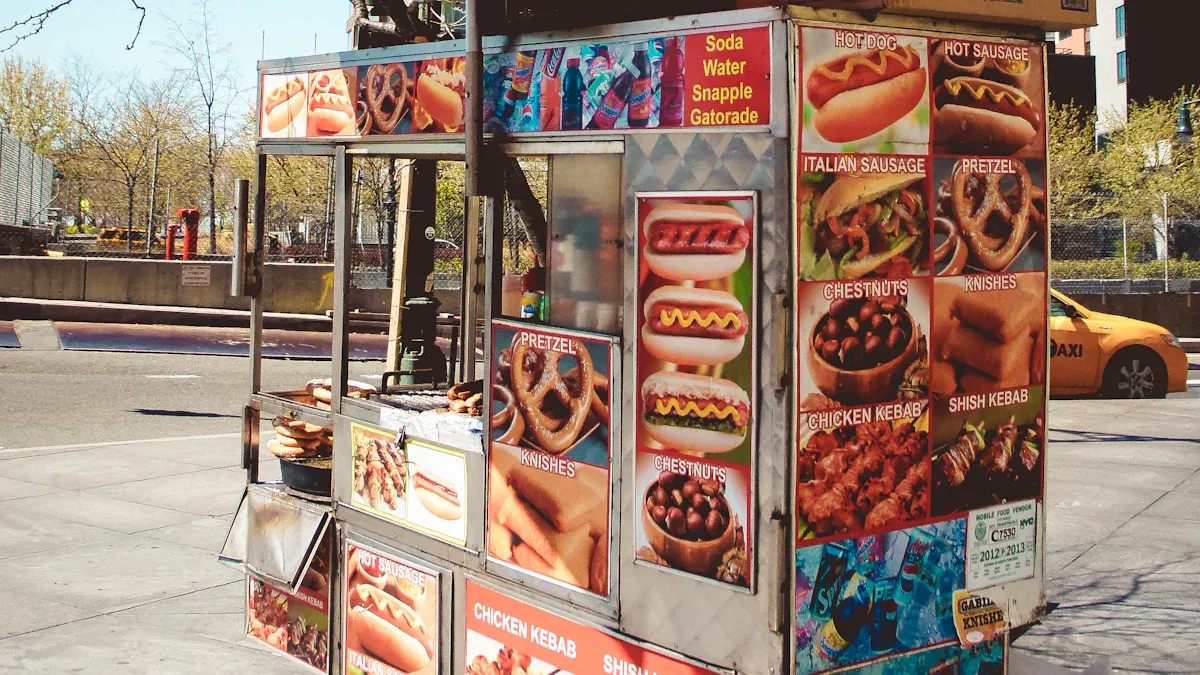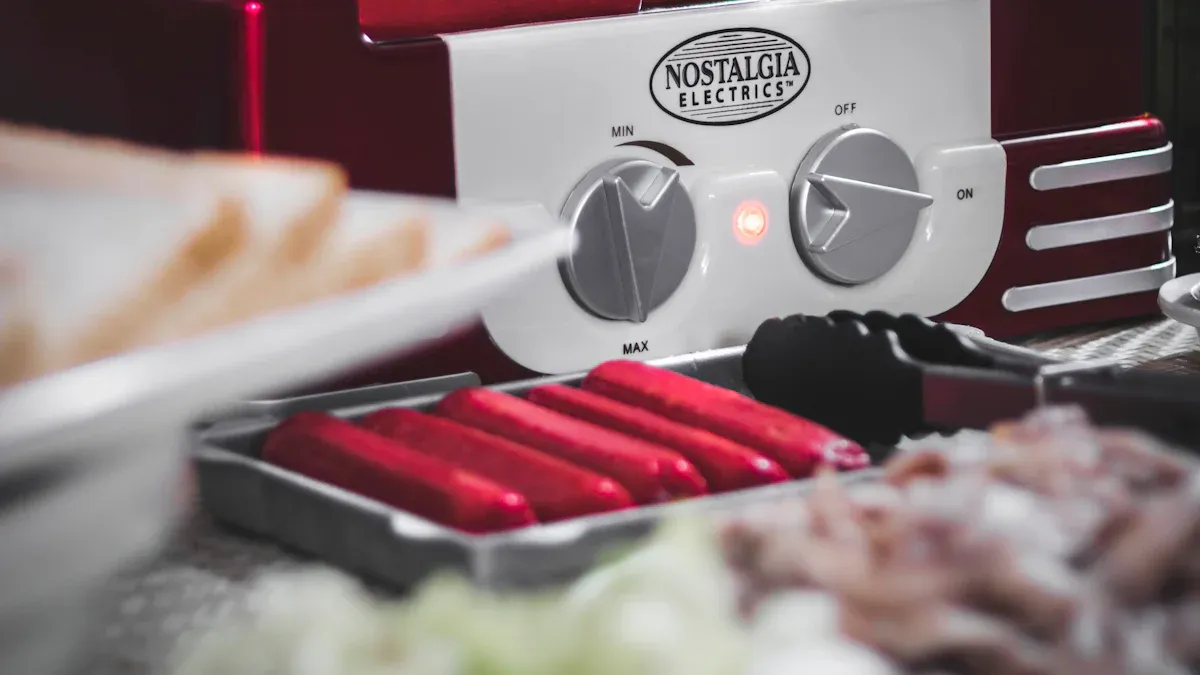The Evolution of Hot Dog Vending Machines

From humble beginnings, vintage hot dog carts have evolved into today’s impressive Hot Dog Vending Machines. The first sausage in a bun appeared on a New York City cart in the 1860s, but true popularity arrived when Nathan Handwerker started selling affordable hot dogs at Coney Island in 1915.
Many Americans see vintage hot dog carts as a symbol of street food culture and community events. Hot dogs hold deep cultural significance, especially during holidays like the Fourth of July. Their journey reflects the significance of innovation, with each era—vintage carts or high-tech machines—shaping the cultural significance of this iconic food.
Key Takeaways
Vintage hot dog carts started in the 1860s and helped make hot dogs a popular street food by offering easy-to-eat meals on the go.
Innovations like Frances E. Coffey’s 1926 patent improved cart design, making hot dog vending more efficient and reliable.
Hot dog vending machines began in the 1940s, using technology to serve hot dogs quickly and conveniently without human help.
Modern machines use smart technology, such as touch screens and data tracking, to offer customization and improve service.
Sustainability and smart features shape the future of hot dog vending, combining vintage charm with advanced technology for a cleaner, faster experience.
History of Vintage Hot Dog Carts

Early Pushcarts
The history of vintage hot dog carts began in the 1860s. German immigrants brought sausage-making traditions to cities like New York and Chicago. They sold sausages from pushcarts, often serving them in buns or milk rolls. This made hot dogs easy to eat while walking. Charles Feltman, a German immigrant, opened the first official hot dog stand on Coney Island in 1871. He sold thousands of sausages in rolls during his first year. The bun innovation helped make hot dogs a popular street food.
Hot dog carts first appeared in neighborhoods with large German populations, such as Manhattan’s East Village.
Vendors served sausages with sauerkraut in buns, making them convenient for busy city life.
The mobility of these carts allowed street vendors to reach many customers in high-traffic areas.
Vintage hot dog carts quickly became a staple in American cities. Their design and function set the stage for future mobile food stands.
Frances E. Coffey’s 1926 Patent
In 1926, Frances E. Coffey received a patent that changed the design of the hot dog cart. Coffey’s invention improved the way vendors could cook and serve hot dogs. The new design included better heating and storage, making it easier for street vendors to keep food warm and fresh. This innovation helped vintage hot dog carts become more efficient and reliable.
Urban Street Food Culture
Vintage hot dog carts played a key role in shaping street food culture. They appeared at parades, festivals, and sporting events, becoming symbols of community and tradition. The carts helped embed hot dogs into American culinary history. Vintage hot dog carts also influenced the food truck revolution, showing that mobile food could be both popular and profitable.
Vintage hot dog carts brought people together and had a strong impact on local communities.
Their presence in public spaces made hot dogs a symbol of shared experiences and nostalgia.
Street vendors used vintage carts to introduce new toppings and styles, adding to the diversity of American food.
The history of vintage hot dog carts shows their lasting impact on local communities and their important place in street food culture.
Evolution of the Hot Dog Cart
Mobility and Design Upgrades
Vintage hot dog carts have changed a lot since their early days. Early vendors pushed their carts by hand, but new designs made things easier. The addition of wheels helped vintage hot dog carts move quickly to busy places. Some carts even used trailer chassis, so vendors could tow them behind cars. This made it possible for vintage hot dog carts to appear at indoor and outdoor events.
Vendors liked towable hot dog carts because they did not need to rent a restaurant.
Mobile vintage hot dog carts solved problems with finding good locations.
Entrepreneurs could move their vintage hot dog carts to where customers gathered.
The design of vintage hot dog carts became more eye-catching and space-saving.
The mobility of vintage hot dog carts helped them spread to world fairs, shopping malls, parks, and parties. Vendors could set up their vintage hot dog carts at public gatherings and attract crowds with their unique look. The ability to move and set up anywhere made vintage hot dog carts a smart choice for many business owners.
Tip: The flexible design of vintage hot dog carts helped vendors save money and reach more customers.
Vintage Hot Dog Carts in Public Events
Vintage hot dog carts became famous at public events. The first hot dog cart in the United States opened in 1867 on Coney Island. Charles Feltman started this trend, and soon, vintage hot dog carts became a common sight at fairs and festivals. Nathan Handwerker later opened a stand that sold hot dogs at half the price, creating Nathan’s Famous. This brand still hosts a popular hot dog eating contest every Fourth of July.
Vintage hot dog carts brought new flavors, like the Texas Dog and Seattle Dog.
In 1936, President Franklin D. Roosevelt served hot dogs from a vintage hot dog cart to the King and Queen of England.
Vintage hot dog carts became part of American culture at baseball games and outdoor events.
Some vendors used vintage hot dog carts to sell gourmet hot dogs with special toppings.
Vintage hot dog carts helped make street food fun and easy to enjoy. Their mobility and design upgrades allowed vintage hot dog carts to become icons at public gatherings. People still remember the excitement of seeing a vintage hot dog cart at a big event.
Hot Dog Vending Machines

The 'Speedy Weeny' Machine
Hot dog vending machines began to change the way people bought street food in the mid-20th century. In 1946, the "Speedy Weeny" machine appeared in New York City. This machine used microwave technology to heat hot dogs in seconds. Customers could insert coins, press a button, and receive a hot dog almost instantly. The "Speedy Weeny" machine marked a shift from manual carts to automated service. People enjoyed the novelty and convenience. The machine showed that technology could make food service faster and easier.
The "Speedy Weeny" machine became a popular attraction in busy places like train stations and movie theaters. People liked the idea of getting a hot dog without waiting in line.
Automation and Technology
Hot dog vending machines continued to evolve with new technology. Modern machines use touch-screen interfaces, sensors, and smart payment systems. These machines can cook, assemble, and serve hot dogs with little human help. Some machines offer choices for toppings and sauces, letting customers customize their orders. IoT connectivity allows operators to track inventory and sales in real time. Data analytics help owners understand customer preferences and improve service.
Machines now use energy-efficient heating systems.
Operators can manage machines remotely using smartphones or computers.
Some machines use artificial intelligence to suggest popular combinations.
Hot dog vending machines have become more reliable and efficient. They provide quick, contactless transactions, which suit busy lifestyles. The machines also meet food safety standards and use sustainable materials. These improvements make hot dog vending machines a smart choice for modern cities.
Global Influence
Hot dog vending machines have influenced the global vending machine industry in many ways. They expanded product offerings beyond snacks and drinks. Machines now serve gourmet, customizable, and regionally inspired hot dogs. This change attracts more customers and increases satisfaction. Strategic placement in high-traffic areas helps machines reach more people. Innovative branding and marketing, including social media campaigns, make hot dog vending machines stand out.
Urbanization and rising incomes drive demand for convenient food options. Regions like Asia-Pacific lead growth, supported by strong digital infrastructure. Regulatory incentives encourage machines to use energy-efficient and sustainable designs. Hot dog vending machines now align with Industry 4.0 standards, using automation and data analytics to improve management and customer interaction.
Region | Growth Factors | Popular Features |
|---|---|---|
North America | Urbanization, tech adoption | Customization, smart payment |
Asia-Pacific | Digital infrastructure, demand | IoT, gourmet options |
Europe | Food safety, sustainability | Energy efficiency, branding |
Hot dog vending machines have inspired other vending solutions to adopt smart, sustainable, and consumer-focused features. They have transformed vending from simple snack dispensers into unique culinary experiences.
Modern Trends and Future
Smart Vending
Smart vending machines have changed the way people buy hot dogs. Unlike vintage hot dog carts, modern machines use advanced technology to improve service and convenience. Many machines now use artificial intelligence to learn what customers like and adjust menus or prices. Internet of Things (IoT) connectivity lets operators track sales and inventory from anywhere. Machine learning helps predict which hot dogs will sell best and when to restock. Some machines use biometric recognition, such as fingerprint or facial scans, to make buying faster and safer. Augmented reality features can show interactive menus or fun games. Touch screens allow customers to pick their favorite hot dog and toppings, just like at vintage hot dog carts. Cashless payments, including credit cards and mobile wallets, make buying easy for everyone.
Operators can monitor machines remotely and keep them full.
Data analytics help vendors know which toppings are most popular.
These features make modern machines more advanced than any vintage hot dog carts.
Sustainability
Sustainability has become important for both new machines and vintage hot dog carts. Many modern machines use energy-efficient designs to save power. Some include recycling bins for customers to throw away bottles or wrappers. Packaging for hot dogs often uses biodegradable or recycled materials. These changes help reduce waste and protect the environment. Even vintage hot dog carts have started using greener materials and energy-saving equipment. The industry wants to make sure that both vintage and modern machines support a cleaner planet.
Energy-efficient machines lower electricity use.
Recycling systems encourage proper waste disposal.
Sustainable packaging is now common in both vending machines and vintage hot dog carts.
What’s Next?
The future of hot dog vending looks bright. Experts predict strong growth for the industry, with more people wanting quick, ready-to-eat meals. Smart vending technology will keep improving, making machines even more efficient than vintage hot dog carts. Health trends will shape new products, with more organic, low-fat, and plant-based hot dogs. Hygiene and safety features, like self-cleaning systems, will become standard. The market is expected to grow in places like Asia-Pacific and the Middle East. Challenges include high costs, food safety rules, and competition from other food options. Still, the mix of vintage charm and modern technology will keep hot dog vending popular for years to come.
Tip: The best machines combine the reliability of vintage hot dog carts with the latest smart features.
Early 20th-century street vendors, especially immigrants, introduced hot dogs to urban food culture.
Regional styles, like New York’s sauerkraut-topped hot dogs and Mexico’s bacon-wrapped versions, highlight global influence.
Modern vending machines use smart technology and sustainable designs to meet changing consumer needs.
Adaptability and innovation have shaped the industry’s significance, helping hot dog vending remain a favorite in every community. The future promises even more creative solutions for quick, tasty meals.
FAQ
How do hot dog vending machines keep food safe?
Hot dog vending machines use temperature controls to keep hot dogs hot and fresh. Sensors monitor the food. Machines often have self-cleaning features. Operators check machines regularly to make sure everything stays safe for customers.
What makes modern hot dog vending machines different from vintage carts?
Modern machines use smart technology, like touch screens and cashless payments. They can track sales and inventory. Vintage carts relied on manual service. Today’s machines offer more choices and faster service.
Can customers customize their hot dogs at vending machines?
Many new machines let customers pick toppings and sauces. Touch screens show options. Some machines even suggest popular combinations. This feature helps people enjoy their favorite flavors.
Are hot dog vending machines eco-friendly?
Many machines use energy-saving systems and recyclable packaging. Some include recycling bins for waste. Operators choose materials that help protect the environment. These steps make vending machines more sustainable.
Where can people find hot dog vending machines today?
People see hot dog vending machines in malls, airports, train stations, and schools. Machines often appear at busy events and public spaces. Their mobility allows operators to place them where many people gather.
See Also
How Vending Machines Transformed From Snacks To Smart Devices
Tracing The Development Of MP3 Vending Machine Technology
Mountain Dew Vending Machines: Journey From Classic To Cutting-Edge
Fast Food Automation Powered By The Future Of Vending
Antique Vending Machines History: Holy Water To Coca-Cola Era
